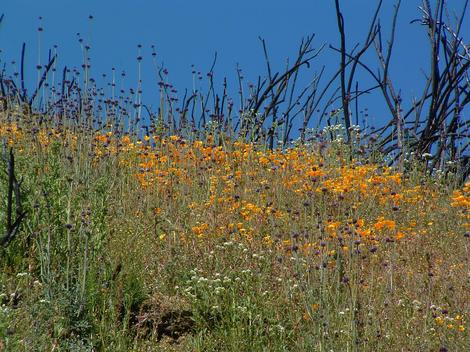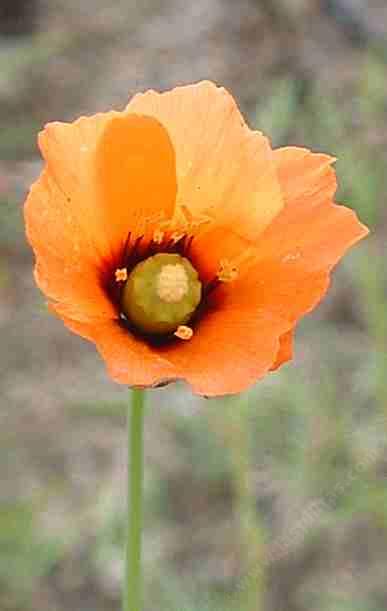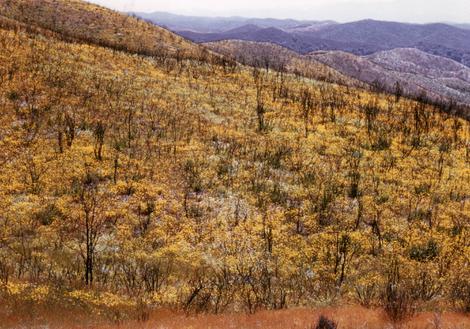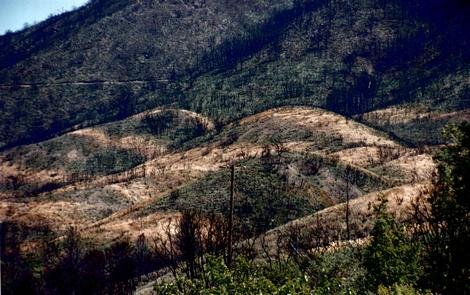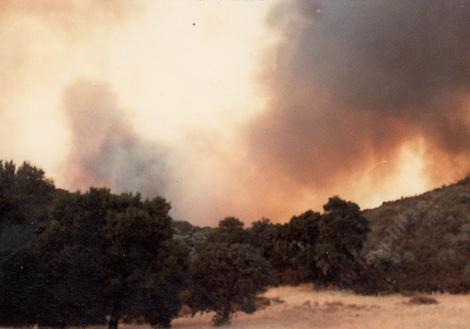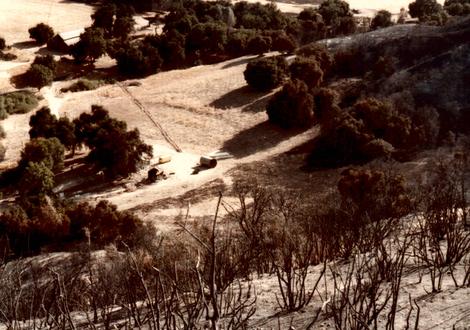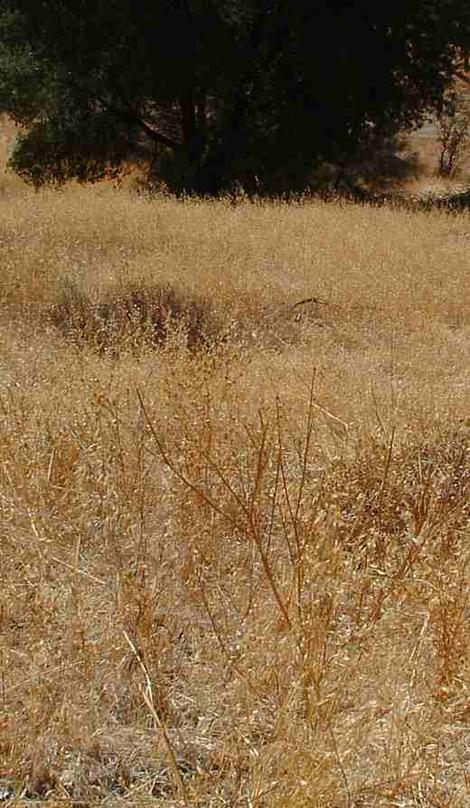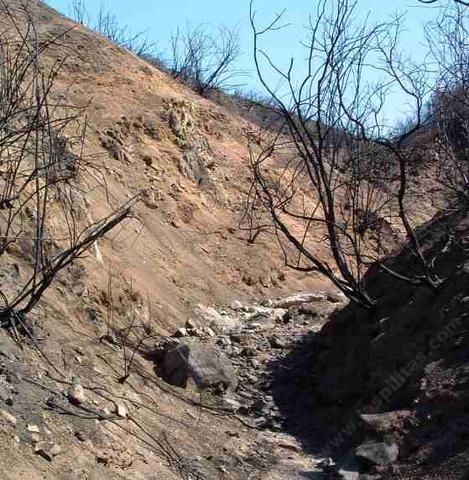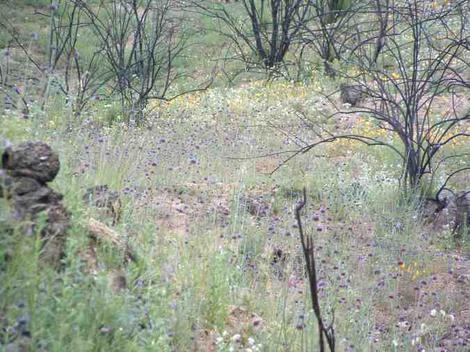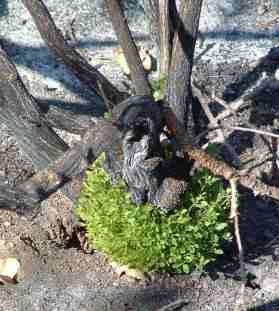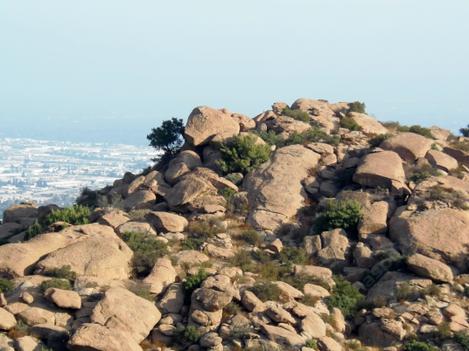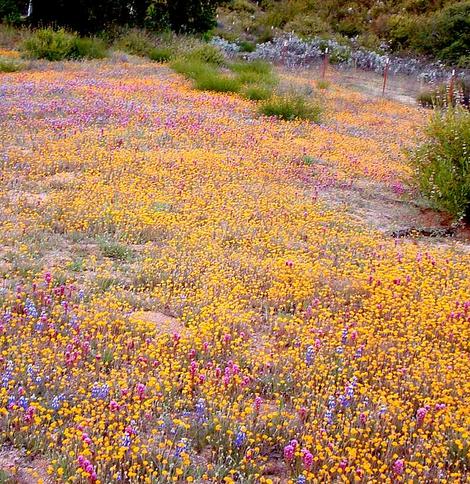POST FIRE
What happens after a wildfire.
Many of the sites
were pristine before the fire and after until well intentioned but
muddleheaded people decided they could do better. We should think long
and hard before we try to be ecological stewards where we need not be.
It is the ultimate in hypocrisy to stop all development in an area
while sanctifying seeding a site after a fire. Planting the wrong plants
into an
ecosystem immediately after a fire destroys the ecology of a site. It
will not recover for centuries, if ever.
An experiment by Mikola et
al(1964) showed that intensive burning can somewhat delay the
commencement of mycorrhizal
infection, but not to a harmful degree. The moonscape sites after fires
will usually revegetate in a few months if we do not interfere. Another
aside is to note about soils and fire. I've heard a lot of people say
they need to seed grass/barley after a fire because of the threat of
erosion. There was no documentation for that. Someone just decided it
was a 'good idea' and folks repeated it.
Many recent studies show this is not true. During the first major rain the native sites have high erosion, and after the third or fourth rain erosion ceases. The seeded grass comes up after the erosion stabilizes, after the third or fourth rain. And seeded slopes can burn early the next spring, non-seeded sites need years before they can burn again.
Fire is a natural occurrence in California. It will happen every 100-250 years in most native areas. Areas with weeds, fire can happen at anytime. Plan for it. (We have a fire list that has more information.) Protect the native vegetation, it is what is holding your hillside together. Native plants have root structures that can grow more than 15 to 25 feet deep. This deep root structure brings moisture up to the surface root systems. After a fire this hydraulic lift provides moisture to the crown-sprouting shrubs, trees and their mycorrhizal associates. It is a beautiful sight to see green growth a few days to weeks after a fire.
The mycorrhizal grid(a finely woven matrix of friendly fungus) holds the surface together and remains intact after a fire. The strongest stabilizer on hillsides is probably this mycorrhizal grid. Mycorrhiza are what keep the sand dunes stable. The sand seems solid until you walk on it. When you walk on it, you disturb the mycorrhizal hyphae freeing up the sand from the hypha connections. The fungus is delicate but, when intact, it will hold the hillside together. (For dramatic pictures of this see Sharon Rose's 1988 article.)
If you think in terms of a human organism, the plant roots are the arms and the mycorrhiza are the fingers. Both are needed to hold the hillside together and they need to be working together for the hillside to be held. In relatively weed free sites(before the fire) disturbance needs to minimized. If the site was an unstable community before the fire, community specific pioneer wildflowers should be reintroduced as soon as possible after the fire. The erosion and restabilization of the soil on that site depends on a smooth and 'clean'(weed free) transition back to a native community. You have that first season to reestablish the plant and fungal community.
Increased
frequency of fires(caused by the "blanket" seeding over huge watershed
areas, of non-plant community specific, or alien plants, or plant
community-specific plants that naturally occur in very small numbers in
a few spots, etc.) or cattle grazing will increase erosion. Fogel found
that 40-85% of a plant community's energy is in underground structures,
including mycorrhiza. The fallacy is after a fire there are no roots on
the site. Little of the mycorrhizal grid and root
grid on a site is disturbed by a fire. It will decline over time,
unless your treat it right. The mycorrhiza is still intact
holding together, seeding grass or other weeds
can shut this down(decouple the grid) by greedily extracting all the
nutrients on the site before the mycorrhizal plants can re-establish
and feed the fungus with carbon(food). (This is food chain blocking.)
The mycorrhizal community collapses, the microfauna eat the fungus,
their community collapses and the system becomes bacterial as the
bacteria eat the dead microfauna. The fungi feed the fauna at the
bottom of the food chain. As the bottom of the food chain collapses
little native vegetation is left, mud slides in winter, fires each
summer as the weeds and grasses take over. Sound familiar?
The pioneer wildflowers capture the nutrition of the site for the fungal grid to recharge, then the shrubs and trees to follow.
No succession can occur without the wildflowers first. (Curtis noticed the same thing. Perry and Choquette raised the possibility that mycorrhizal associations facilitates this succession(or lack of).) What has been happening in many areas is a cycle of fire, seeding junk, fire, and all weeds. Each time the cycle gets shorter. The "micro- and macrofauna in the upper 50 mm of the mineral soil in unburned areas is ...11 times as dense as in [regularly] burned sites.....Fire-induced reduction in the porosity of these soils was attributed to this faunal impoverishment."(Daubenmire)
Basically weeds make for very poor drainage and the rain water runs
off.
The
other reason (I want to cry when I hear it, stupoid, (as I'm told
stupid idiot is not polite)) is
because 'all the seeds burnt up (or off) during the fire'. Our
natives
have been through hundreds if not thousands of wildfires, if the seeds
were going to 'burn up' they would not be there! Where do people get
these ideas? This is simply not true. Many burnt sites that
have the fired bricked soil with no signs of organic debris. No bumps,
no stumps, no twigs, no seeds visible, nothing! These are the sites
that have the best growth of secondary colonizing Ceanothus seedlings
and pioneer Lotus(Deerweed). Dry soil is a good insulator, fires can
reach 400-670 deg. F(200-350 C.) but the temperature 1-5 cm (1-2
inches)
down remains normal. Daubenmire
reported grass fire temperatures of 720 degrees C., ( hot enough to
melt Aluminum, Lead, Magnesium, Tin and Zinc,) at a depth of 2 cm. (one
inch) the temperature was elevated only 14 deg. C.. That means if the
soil temperature was 75 degrees F.(23 C.) when the fire started it was
raised to 100 deg. F.(37 deg C.), which might be no more than a soil
site with no plant cover. In dry soils "spores and infected roots
present below the lethal point should provide an ample source of
inoculum for young seedlings." (Pendleton and Smith) If the soils are
wet, everything changes, as in winter with prescribed burns, 95% of the
soil bacteria and a greater amount of soil fungi are killed. Mt' Saint
Helen blew up and covered miles of vegetation with many feet of
hot rock and ash, within a couple of years native plants were coming
back.
On our site that was
'seeded with grass' the native pioneers survived in only the most
harshest spots where the grass failed. In the transition communities
there was
little survival of germinating native species. We also got one of the
star thistles and a filaree from the cheap seed they used.
Fires are natural. They happen on their own every 100-250+years. Intervals less than 50-60 years do not allow the long-cycle plants to build up a seed pool. Annual grasses decrease this interval, sometimes to months.
What is so intriguing is Hoover(Flora of SLO Co.) repeatedly pointed all this out in the 1960's. Where has all the misinformation come from?
About Lolium: A quote from Robert F. Hoover (Vascular Plants of San Luis Obispo County, 1970),
"L. perenne. Perennial Rye-Grass. Commonly included in seed mixtures for low-quality or temporary lawns and often persisting or escaping, especially in places which are at least temporarily moist. This is probably also the species which is extensively sown, under the erroneous name of "rye" after forest and brush fires. This practice cannot be too strongly condemned, because seeds of native plants are abundantly present to grow under favorable conditions after fires, and those desirable native species are too easily crowded-out by the worthless Lolium."
This is from the article most quoted for seeding (I kid you not, it is commonly the ONLY article quoted to justify seeding.)
"Such reseeding is done with four principal objectives:(1) to provide forage for game and livestock, (2) to provide a plant cover to lessen soil erosion, (3) to furnish competition to reduce survival of brush seedlings, and (4) to supply fuel for a reburn to further reduce the brush cover if necessary."
In 1994 the was the Hwy. 41 fire. We attempted to stop the seeding after the fire. The governmental agencies involved(Calif. Division of Forestry, U.S. Forest Service, etc.) Gave a public hearing where they announced they were 'only' going to seed with the 'Native' Cucamonga Brome(Bromus carinatus) 15,000 acres of pristine chaparral trying to 'avoid' the areas of rare and endangered plants. (They were going to seed 75,000 acres before we starting mailing letters to the media and politicians. Senator Feinstein deserves credit for helping.) When they seeded they used helicopters, the pattern became obvious as the following pictures show. The green is the unseeded area the straw colored areas are dead grass.
A study a mile away from the site, done in 1989 found "the number of shrub seedlings in the ryegrass-seeded flats of burn soil were much lower than those in the unseeded flats. Heights of native seedlings in the ryegrass-seeded flats were also less than in the control flats... Seeding of ryegrass was not effective in reducing erosion in ten of the eleven study sites of this experiment; in fact, average sediment yield was greater in seeded plots." Charles Lane Curtus, 1989. Moreover Patric in 1974 found that grass seeded sites had much greater erosion than sites vegetated with native species. Sites seeded paralleled bare soil sites in runoff and erosion.
"Seeding has a low probability of reducing the first season erosion because most of the benefits of the seeded grass occurs after the initial damaging runoff events."Robichaud, Peter R., Jan L. Beyers and Daniel G. Neary
